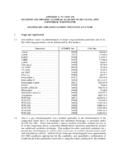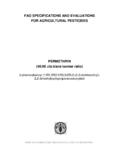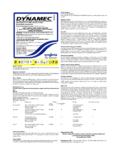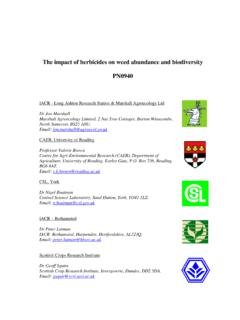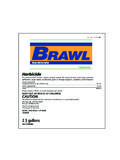Transcription of Sustainable Management of the Fall Armyworm in …
1 Sustainable Management of the fall Armyworm in Africa FAO Programme for Action 6 October 2017 Executive Summary The invasive insect pest, fall Armyworm , FAW (Spodoptera frugiperda) continues to spread across Africa, affecting millions of smallholder maize producers across the continent. In addition to its preferred maize, FAW can feed on more than 80 plant species, including rice, sorghum, millet, sugarcane, vegetable crops and cotton. FAW can cause significant yield losses if not well managed or in the absence of natural biological control.
2 Unlike quarantine pests under official control or insects with gregarious behaviour ( some locust species), FAW does not lend itself to official, centralized control. FAW moths oviposit directly on maize plants, where the larvae feed and live. They are one more risk that farmers face in growing maize. The direct actions that can be taken to manage FAW are largely up to farmers in their fields. Thus the main focus and majority of resources should be aimed at helping farmers do their job better. Farmers need understanding, advice, tools, resources, risk Management , and a conducive environment to sustainably manage FAW.
3 Farmers need to first understand what FAW is how to identify it and understand its biology & ecology. They need to be able to determine the risk level in the context of their production systems, and take appropriate actions, both preventive and responsive, based on their assessments. The information and resources that they have at hand largely depend on the context in which they function. That context is influenced by many actors and interests, with public institutions and organizations purveyors of public goods playing a very important, but not exclusive role.
4 FAO and its partners will help at all levels: to help determine and disseminate best recommended practices to smallholder farmers, help in the assessment and use of risk analysis, facilitating and supporting the refinement and application of near-term solutions, and helping to shape the policy and technical environment that farmers face. Some advice and recommendations are directly available from the Americas, where both maize and FAW are native. Maize farmers in the Americas have been managing FAW for centuries.
5 However, the ecological and economic contexts are quite different between the typical maize farmer in the Americas and those of Africa. A Sustainable integrated FAW Management programme appropriate for the African context needs to be rapidly communicated and practiced by tens of millions of smallholder maize farmers across the continent. The context is shaped by public policies and programmes, thus it is also urgent that governments fully appreciate the threat that FAW possess and adopt policies and programmes that help promote Sustainable responses to the new threat.
6 To this end, FAO has prepared this Programme for Action to help support Sustainable Management of FAW in Africa. FAO proposes a five-year programme of action to help farmers, their organizations, their public institutions, national governments and development partners quickly respond the challenges of FAW infestation in smallholder farmers fields across Africa. This Programme has a total cost of USD million. FAO will train National Plant Protection Organizations, extension services, and farmers via Farmer Field Schools, to quickly get the appropriate action in the field, avoiding the pitfalls of possible miss-steps, while simultaneously filling knowledge gaps, innovating for future solutions, developing local capacities, promoting local empowerment and rural youth employment and coordinating among partners to maximize results and minimize inefficiencies.
7 FAO works closely with its development and resource partners to maximize coordinated results and minimize duplications. To this end, FAO has worked with partners in developing a coordinated FAW Framework that takes into account all FAW response interventions regardless of funding sources. FAO will take an active role in coordinating among all partners activities, plans, and approaches to provide Sustainable solutions to the FAW challenge. FAO has prepared this Programme for Action in the context of that Framework.
8 This Programme presents to development and resource partners that part of the Framework actions that FAO is prepared to directly coordinate and administer. Many of the activities described here include the active participation of partners and service providers. FAO will develop the appropriate Letters of Agreement or Contracts under which the obligations and responsibilities of all parties will be defined. FAO specifically leaves certain work to partners comparative advantages and organizational missions better dedicated to those areas of work ( longer-term research).
9 FAO focusses on its comparative strengths to propose this Programme divided into six components: 1. Management of FAW: Immediate Recommendations & Actions 2. Short-term Research Priorities 3. Communications & Training 4. Monitoring & Early Warning 5. Policy & Regulatory Support 6. Coordination Acronyms AGRA Alliance for a Green Revolution in Africa AU African Union CABI Centre for Agriculture and Bioscience International CARE Cooperative for Assistance and Relief Everywhere CBO Community-based Organization CGIAR Consultative Group on International Agricultural Research CILSS Permanent Interstate Committee for drought control in the Sahel CYMMIT International Maize and Wheat Improvement Center EAC East African Community ECCAS Economic Community of Central
10 African States ECOWAS Economic Community of West African States EU European Union FAO Food and Agriculture Organization FAO-HQ FAO Headquarter FAW fall Armyworm FEWSNET Famine Early Warning Systems Network FFS Farmer Field GEF Global Environment Facility GIS Geographic Information System GPS Geographic Positioning System HHP Highly Hazardous Pesticides IAPSC Inter African Phytosanitary Council ICIPE International Centre of Insect Physiology and Ecology ICT Information and Communication Technologies IFAD International Fund for Agricultural Development IGAD Intergovernmental Authority on Development IITA International Institute of Tropical Agriculture INSA Institut du Sahel IPC Integrated Phase Classification IPM Integrated Pest Management NAR National Agricultural Research NGO Non-governmental organization NPPO National Plant Protection Organization NPV Nuclear Polyhedrosis Virus OXFAM Oxford Committee for Famine Relief PC Personal Computer PSU Penn State University











